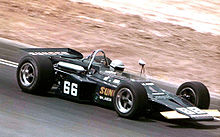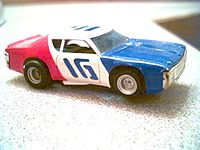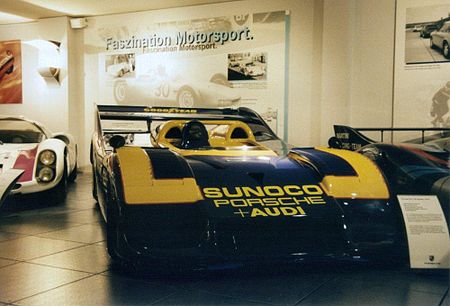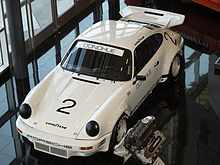- Mark Donohue
-
Not to be confused with Mark Donahue, the American football player.
Mark Neary Donohue, Jr. (March 18, 1937 – August 19, 1975), nicknamed "Captain Nice", was an American racecar driver known for his ability to set up his own race car as well as driving it to victories. Donohue is probably best known as the driver of the 1500+ bhp “Can-Am Killer” Porsche 917-30 and as the winner of the 1972 Indianapolis 500. Cars that Donohue raced include: AMC Javelin, AMC Matador, Chevrolet Camaro, Eagle-Offy, Elva Courier, Ford GT-40 MK IV, Ferrari 250LM, Ferrari 512, Lola T70, Lola T330, Lotus 20, McLaren M16, Porsche 911, Porsche 917/10, Porsche 917/30, Shelby Cobra, and Shelby Mustang GT350R.
Early life
Donohue was born in Haddon Township, New Jersey and grew up in Summit, New Jersey.[1] He attended the Pingry School in Hillside, New Jersey and upon graduation, he entered Brown University in Providence, Rhode Island. Donohue was graduated in 1959 with a bachelors degree in mechanical engineering and began racing his 1957 Corvette casually at the age of twenty-two. He won his first event, a Belknap County, New Hampshire hillclimb, in that car. Eventually, through networking with various SCCA drivers, he was introduced to a well-known retired race driver and as-yet unsuccessful race team owner named Roger Penske.
Donohue met an experienced race driver named Walt Hansgen while running in SCCA events around the country (driving an Elva Courier with which he won the SCCA national championship in 1960 and 1961). Hansgen quickly realized that Donohue had unusual talent as a driver, but more importantly, had an extensive working knowledge of vehicle mechanics and dynamics, due to his engineering background. Hansgen befriended Donohue, and even provided an MGB for Donohue to race at the 1964 Bridgehampton 500-mile (800 km) SCCA endurance event, which Donohue won.
In 1965, Hansgen invited him to co-drive a Ferrari 275 at the 12 Hours of Sebring endurance race. This would be Donohue's big break into international sports-car racing. Hansgen and Donohue combined to finish 11th in that race. Also in 1965 Mark drove a GT350 to a SCCA B Class championship and a Lotus 20 to another championship in SCCA Formula C.
The Ford GT40
The year 1966 proved frustrating for Donohue. Thanks to his friendship with Hansgen, word quickly spread to the Ford Motor Company about the young driver. Ford immediately signed Donohue to drive one of their GT-40 Mk II race cars campaigned at the 24 Hours of Le Mans by the Holman & Moody racing team. Donohue partnered with Australian Paul Hawkins. Donohue and Hawkins only completed twelve laps and finished 51st.
Donohue was invited back to Le Mans by Ford the following year. Ford had developed a new GT-40, the Mark IV. Donohue co-drove in the #4 yellow car with sports car driver and race car builder Bruce McLaren for Shelby American Racing. The two drivers disagreed on many aspects of racing and car setup, but as a team were able to muster a fourth-place finish in the endurance classic.
The year culminated with Roger Penske contacting Donohue regarding his possible interest in driving Penske's brand new Lola T70 spyder in the United States Road Racing Championship. The start was hardly propitious, as Mark destroyed the car at Watkins Glen in June, [1] crashing the car at the top of a hill, where it burned to the ground.
Donohue dominated the 1967 United States Road Racing Championship, driving a Lola T70 MkIII Chevy for Roger Penske. Donohue raced in seven of the eight races that year, winning six (at Las Vegas, Riverside, Bridgehampton, Watkins Glen, and Mid-Ohio, while finishing third at the Laguna Seca round behind Lothar Motschenbacher and Mike Goth.
In 1968, Donohue and Penske returned to defend their USRRC championship with the McLaren M6A Chevrolet. Donohue did not participate in the first race of the year at Circuit Hermanos Rodriguez in Mexico City. Yet, Donohue still dominated the series, even though he suffered three DNFs (did not finishes) during the season due to mechanical problems with the M6A.
Trans-Am
Donohue began his historic Trans-Am series campaign in 1967, winning three of twelve races in a Roger Penske-owned Chevrolet Camaro. In 1967 and 1968, Trans-Am schedule included two of the most prized endurance races in the world, the 24 Hours of Daytona and the 12 Hours of Sebring. Donohue finished fourth at Daytona and won the Trans-Am class at the 12 Hours of Sebring.
1968 would be a banner year for Donohue in the Trans-Am series, as he successfully defended his 12 Hours of Sebring victory by partnering with Craig Fisher and driving his Penske Chevy Camaro to victory. Donohue went on to win 10 of 13 races, a Trans-Am series record which would stand until Tommy Kendall went 11 for 13 in the 1997 Trans-Am championship, winning the first 11 races that year in his All-Sport liveried Mustang.
Donohue was considered the leading Trans-Am driver of the late 1960s and early 1970s. His Camaros and Javelins won three Trans-Am championships (his last in 1971) while driving Camaros and AMC Javelins, all for Roger Penske Racing.
During their enormous success in Trans-Am, Roger and Mark would begin to experiment with their Camaros. They discovered that dipping a car's frame in an acid bath would eat away small amounts of metal from the frame, which in turn made the car incrementally lighter, and allowed it to be driven faster around the track. The 1967 Z-28 won its last race by lapping the entire field of cars, raising eyebrows throughout the paddock.[citation needed]
During a post-race inspection, race stewards discovered that the car was 250 pounds lighter than the 2800-pound minimum weight requirement. Donohue was about to have his race victory taken away for cheating, but Roger Penske stepped in. Penske warned that any disqualification would have the potential of motivating Chevrolet to pull all support for the Trans-Am series. After considering the potential consequences, the race stewards allowed Donohue's victory to stand, but the rules for the 1968 season incorporated a change whereby all cars would be weighed during the technical inspection before the race.
Penske and Donohue did not stop acid-dipping after this, however. Continuing the practice of reducing the frame weight allowed them to place weights of certain sizes strategically in specific locations within the car, thus helping to balance the car while being driven on the limit.
They continued to use the "lightweight" car in 1968, at the Sebring 12-hour race. They changed the grille and taillight to the 1968 model, and then painted both cars identically. They sent the legal weight car through the technical inspection with the number 15 and again with the number 16 on it. Then they put both cars in the race, number 15 and 16, one car being 250 pounds lighter. They won the race, finished 3rd overall, and went on to win 10 out of 13 races that year.
They also acid-dipped the body on the Camaro and had to caution people not to lean against it, for fear it would dent.
The lightweight car was featured on an episode of Dream Car Garage on Speed TV in 2005.
Donohue and Penske tackle the Indianapolis 500
 Mark Donohue won the inaugural Pocono 500 at Pocono Raceway in 1971
Mark Donohue won the inaugural Pocono 500 at Pocono Raceway in 1971
In 1969, Penske and Donohue raced in their first Indianapolis 500, where Donohue finished seventh, winning the rookie of the year award. Donohue raced at Indianapolis each year following, finishing second in 1970 and 25th in 1971.
Donohue won the 1972 Indianapolis 500, driving as always for Roger Penske. He finished the race in his McLaren-Offy setting a record speed of 162 mph, which would stand for twelve years. The victory was the first for Penske in the Indy 500.
NASCAR
Donohue raced in several NASCAR Grand American races, a NASCAR pony car division from 1968 until 1971. In 1973, driving an AMC Matador for Penske Racing in NASCAR's top division, the Winston Cup Series, Donohue won the season-opening event at Riverside.
That race was Penske's first NASCAR win in a long history of NASCAR participation and remains to this day, the last non-regular (non-full schedule) driver (road course ringer) to win a NASCAR Winston Cup road race.
Although photographs of Donohue with the more aerodynamic 1974 Matador coupe exist and are published, he did not drive it in competition.
The alleged Can-Am Killer
Between 1972 and 1973, Penske Racing (along with Donohue as the primary test and development driver) was commissioned by Porsche to assist with development of the 917/10. Donohue extensively tested the 917-10, offering up his substantial engineering knowledge to the Porsche engineers in order to design the best possible race car to compete in the Can-Am series. Donohue's desire to succeed almost led to his undoing. During testing of the 917-10 at Road Atlanta, Donohue had recommended larger brake ducts to the Porsche engineers, in order to provide more efficient cooling, and thus less fade and degradation as a race wears on.
The Porsche engineers obliged, but in doing so, caused the new brake ducts to interfere with the bodywork closure pins, which attach the bodywork to the car. Coming out of turn seven, the rear bodywork flew off the car at approximately 150 mph (240 km/h), causing the car to become extremely unstable. The car lifted off the ground and tumbled multiple times down the track. The front of the car was completely torn away, leaving Donohue, still strapped to his safety seat, with his legs dangling outside the car. Amazingly, Donohue only suffered a broken leg. George Follmer, Donohue's old Trans-Am teammate, resumed testing the 917-10 while Donohue was recuperating. In classic Donohue style, Donohue said of Follmer testing his car:
“ It just doesn't feel right. Seeing another man driving your car, a car you know so well. I imagine it must feel like watching another man in bed with your wife. ”
Porsche, Penske, and Donohue quickly started the development of the 917-30, complete with a reworked aerodynamic "Paris" body and a 5.4-liter turbocharged Flat-12 engine whose output could be adjusted between approximately 1100 and 1500 bhp by turning a boost knob located in the cockpit. During the development of this motor, the German Porsche engineers often asked Donohue if the motor finally had enough power. His tongue-in-cheek answer was "it will never have enough power until I can spin the wheels at the end of the straightaway in high gear."The 917-30 is referred to, erroneously, as "The Can-Am Killer" as it dominated the competition, winning every race but one of the 1973 Can-Am championship, however, the SCCA imposed fuel limitations for all Can-Am races due to the existing Arab Oil Embargo. Because of this, Porsche and McLaren withdrew from the series. It generally is considered one of the most powerful and most dominant racing machines ever created.
Retirement and Formula One
Donohue announced that he would retire from racing after the 1973 Can-Am season. In addition, the horrific events at the 1973 Indianapolis 500 and the subsequent death of his friend, Swede Savage, pushed him to quit. His retirement was short-lived, however, as he was lured back to full-time competitive driving by Roger Penske when Penske formed a Formula One team, Penske Cars Ltd, to compete in the final two events of the 1974 Formula One World Championship, and to continue competing in 1975 with the new Penske PC1.
 Mark Donohue
Mark DonohueBorn March 18, 1937 Died August 19, 1975 (aged 38) Formula One World Championship career Nationality American Active years 1971, 1974 - 1975 Teams Penske and Penske-entered McLaren and March chassis Races 16 (14 starts) Championships 0 Wins 0 Podiums 1 Career points 8 Pole positions 0 Fastest laps 0 First race 1971 Canadian Grand Prix Last race 1975 Austrian Grand Prix Donohue previously had debuted in Formula One on September 19, 1971 with a Penske-sponsored McLaren at the Canadian Grand Prix at Mosport Park, finishing on the podium in third place. After being lured out of retirement by his former boss, Penske, Donohue returned to Formula One, entering into the final two races of the 1974 Formula One season. Donohue finished in 12th place at the Canadian Grand Prix, but failed to finish at the United States Grand Prix.
A full-on assault of the 1975 Formula One season was planned. The 1975 season turned out to be a difficult one for Donohue and Penske. Donohue was able to muster 5th place finishes at the Swedish Grand Prix and the British Grand Prix, but the new Penske PC1 chassis proved problematic, as evidenced by three retirements in the first six races. At the Austrian Grand Prix, Donohue's career, along with Roger Penske's Formula One aspirations, would take a tragic turn.
The first IROC Champion
Donohue raced in the inaugural IROC series in 1973/74, racing identical, specially-prepped Porsche RSRs. Of the four-race series, Donohue won the first two races at Riverside and the final race of the year at Daytona. The only person to beat Donohue was his former Penske Trans-Am teammate, George Follmer. In winning the first IROC championship, Donohue beat the best-of-the-best racing drivers of that era from all of the major championships, such as Denny Hulme, Richard Petty, A.J. Foyt, Emerson Fittipaldi, Bobby Allison, David Pearson, Peter Revson, Bobby Unser, and Gordon Johncock.
Donohue, Penske, and Porsche decided to set their goals very high with the 917-30. After making various aerodynamic and suspension modifications to the car, Donohue set the then world closed-course record driving the Porsche 917-30 at the Talladega Superspeedway in Talladega, Alabama on August 9, 1975. His average speed around the 2.66-mile (4.28 km) high-banked oval was 221.120 mph (355.858 km/h). Donohue held the world record for eleven years, until it was broken by Rick Mears at Michigan International Speedway.
The following quote has been attributed to Donohue: "If you can make black marks on a straight from the time you turn out of a corner until the braking point of the next turn, then you have enough horsepower."
Death and legacy
Midway through the 1975 F1 season, Penske abandoned the troublesome PC1 and started using the March 751. Donohue recently had arrived in Austria for the Austrian Grand Prix at the Österreichring race track following the successful closed-course speed record attempt at Talladega Superspeedway in Alabama just a few days earlier. During a practice session for the race, Donohue lost control of his March after a tire failed, sending him careening into the catch fencing at the fastest corner on the track, Vost-Hugel. A track marshal was killed by debris from the accident, but Donohue did not appear to be injured significantly. It is said that Donohue's head struck either a catch fencing post or the bottom of the wood frame for an advertising billboard located along side of the racetrack. A headache resulted, however, and worsened. After going to the hospital of Graz the next day, Donohue lapsed into a coma from a cerebral hemorrhage and died.
Commemorations and legacy
In 2003, in commemoration of Penske Racing's 50th NASCAR win, Nextel Cup driver Ryan Newman drove a Dodge Intrepid painted to resemble Donohue's 1973 AMC (with a #12 and current Alltel decals) at the fall Rockingham, North Carolina race. Penske's first NASCAR win came at the hands of Donohue.
Roger Penske's new Penske Racing complex in Mooresville, North Carolina is decorated with various murals of Donohue and his racing cars, most notably the AMC stock car and the various Porsche prototypes that Donohue drove through his career.
Mark Donohue chronicled his entire racing career in the book, The Unfair Advantage (co-written with noted motorsports and engineering journalist Paul Van Valkenburgh). The book documents his career from his first races to his final full season of racing the year before he was killed. This was not merely an celebrity autobiography, but a detailed, step-by-step record of the engineering approach he took to getting the absolutely highest performance from every car he drove, always looking for that elusive "unfair advantage". Donohue (along with Penske) were pioneers in many rights, some as notable as the use of a skidpad as a tool for developing and perfecting race car suspension designs and setups. The book told how Donohue learned to exploit the antilock braking system and the powerful turbocharged engine of several prototype Porsches, as well as how he learned from various mishaps, including a near-fatal crash. Penske and Donohue also improved upon a process called "acid dipping" when racing in the 1967 and 1968 Trans-Am series, as discussed above. The book was published shortly before Donohue's death.
The book was re-released in 2000 by Bentley Publishers (Cambridge, Massachusetts). It includes information and additional photography that was not available before the first edition was published, but understandably had few new events to describe, aside from the author's death.
Donohue's racing tradition is carried on by his son, David Donohue, a successful road racer in his own right. He currently races a Daytona Prototype Porsche Riley for Brumos Racing in the Grand-Am racing series, who won the 2009 Rolex 24 Hours at Daytona.
Awards
- Mark Donohue was inducted into the International Motorsports Hall of Fame in 1990.
- He was inducted in the Sports Car Club of America Hall of Fame in its 2006 class.[2]
Complete Formula One World Championship results
(key)
Year Entrant Chassis Engine 1 2 3 4 5 6 7 8 9 10 11 12 13 14 15 WDC Points 1971 Penske-White Racing McLaren M19A Ford V8 RSA ESP MON NED FRA GBR GER AUT ITA CAN
3USA
DNS16th 4 1974 Penske Cars Penske PC1 Ford V8 ARG BRA RSA ESP BEL MON SWE NED FRA GBR GER AUT ITA CAN
12USA
RetNC 0 1975 Penske Cars Penske PC1 Ford V8 ARG
7BRA
RetRSA
8ESP
RetMON
RetBEL
11SWE
5NED
8FRA
Ret15th 4 March 751 GBR
5GER
RetAUT
DNSITA USA Indy 500 results
Year Chassis Engine Start Finish Entrant 1969 Lola Offy 4th 7th Penske 1970 Lola Ford 5th 2nd Penske 1971 McLaren Offy 2nd 25th Penske 1972 McLaren Offy 3rd 1st Penske 1973 Eagle Offy 3rd 15th Penske See also
- Roger Penske
- Indianapolis Motor Speedway
- George Follmer
- Walt Hansgen
- Skidpad
- Turbocharger
- Brown University
- Lola Cars
- Vehicle Dynamics
- Elva (car manufacturer)
References
- ^ Katz, Michael. "Donohue, on the Way Out, Views Things From Top; Calendar of Motor Sports", The New York Times, November 4, 1973. Accessed February 18, 2011. "In the nineteen fifties, when Dwight Eisenhower was President and Marilyn Monroe was the queen and Elvis Presley was becoming king, Mark Donohue was growing up in Summit, N.J., 'when the hot rod phenomenon came East from California and caught me up in it.'"
- ^ 2006 SCCA Hall of Fame Class Announced; Champions Buffum, Donohue Among Inductees, Retrieved January 11, 2007
External links
- Mark Donohue's IROC and NASCAR stats at racing-reference.info
- Mark Donohue Photos
- Road Racing Drivers Club see - deceased members bio list - biography and photograph (includes biographies of all ever invited to join Road Racing Drivers Club, living and deceased)
- AMX-perience Mark Donohue Tribute Page
- Jayski's Mark Donohue tribute
- The Greatest 33
Sporting positions Preceded by
George FollmerTrans-Am
Champion
1968-69 - Chevrolet CamaroSucceeded by
Parnelli JonesPreceded by
Bill Vukovich IIIndianapolis 500
Rookie of the Year
1969 - Lola-OffySucceeded by
Donnie AllisonPreceded by
Parnelli JonesTrans-Am
Champion
1971 - AMC JavelinSucceeded by
George FollmerPreceded by
Al UnserIndianapolis 500
Winner
1972 - McLaren M16-OffySucceeded by
Gordon JohncockPreceded by
George FollmerCan-Am
Champion
1973 - Porsche 917-30Succeeded by
Jackie OliverPreceded by
First ChampionInternational Race of Champions
Champion
1973/74 - Porsche RSRSucceeded by
Bobby UnserPreceded by
Helmut KoiniggFormula One fatal accidents
August 19, 1975Succeeded by
Tom Pryce3/6/24 hrs + 2000km winners at Daytona Five-time Four-time Three-time Two-time Mauro Baldi · Terry Borcheller · Elliott Forbes-Robinson · A. J. Foyt · Al Holbert · Jan Lammers · Ken Miles · Juan Pablo Montoya · John Paul, Jr. · Memo Rojas · Lloyd Ruby · Wayne Taylor · Didier Theys · Al Unser, Jr.
One-time Amon · J. Andretti · Ma. Andretti · Angelelli · Ballot-Léna · Bandini · Barber · Barbosa · Beretta · Bergmeister · Bernhard · Boesel · Bouchut · Boutsen · Brundle · Buckler · Collard · Dalziel · Dismore · Dixon · D. Donohue · M. Donohue · Dupuy · Durán · Duxbury · Dyson · Elford · Fellows · Field · Fittipaldi · Fitzpatrick · Franchitti · Fréon · García · Garretson · Gentilozzi · Graves · Gurney · Hand · Hasemi · Helmick · Henn · Herrmann · Hezemans · Hill · Hoshino · Ickx · Jelinski · Joest · D. Jones · P. Jones · Kinnunen · Kneifel · Krages · Lässig · Lavaggi · Law · Lienhard · Luyendyk · Martin · Mears · Merl · Millen · Moran · Moretti · Neerpasch · Nielsen · O'Connell · Oliver · Ongais · Pace · Papis · Parsons · Paul, Sr. · Pescarolo · Pilgrim · B. Rahal · G. Rahal · Rice · Robinson · Rockenfeller · Schneider · Schrom · Sharp · Siffert · Suzuki · Unser, Sr. · van der Merwe · Weaver · Wendlinger · Werner · Wheldon
Categories:- 1937 births
- 1975 deaths
- American Formula One drivers
- American racecar drivers
- Brown University alumni
- Pingry School alumni
- NASCAR drivers
- Indianapolis 500 drivers
- Indianapolis 500 Rookies of the Year
- Indy 500 winners
- Trans-Am drivers
- International Motorsports Hall of Fame inductees
- International Race of Champions drivers
- People from Summit, New Jersey
- Racecar drivers killed while racing
- Sport deaths in Austria
- 24 Hours of Le Mans drivers
- 24 Hours of Daytona drivers
Wikimedia Foundation. 2010.



